- India
- International
Did you know all plants and trees were once called vegetables?
Originally, "vegetable" referred to all plant life. Imagine calling a majestic bargad tree a vegetable! So how did the modern vegetable come to be? Let's find out
 Dive into the surprising history of the word and how it came to define the delicious, nutritious foods we know today. (Source: Freepik)
Dive into the surprising history of the word and how it came to define the delicious, nutritious foods we know today. (Source: Freepik)The word “vegetable” has come a long way from its roots in describing all living things. Today, it sits firmly in our vocabulary, designating a specific category of food. But how did this word evolve, and what exactly qualifies something as a vegetable?
We were especially surprised when we stumbled upon this reel deeming that vegetables don’t exist. The reel talks about how all vegetables, which are termed so, are actually different things. For example, a potato is a tuber, and spinach is a leaf.
We reached out to Sangeeta Khanna, a nutrition and culinary consultant to understand the history behind the word.
Our journey begins in the Proto-Indo-European language, where the root *weg- or *wog- meant “to be strong, be lively.” This essence carried over into Latin, where “vegetabilis” emerged, meaning “growing, flourishing.” French borrowed the word as “vegetable” in the 15th century, and it entered English soon after.
Originally, “vegetable” referred to all plant life. Imagine calling a majestic bargad tree a vegetable!

Khanna said, “Vegetabilis is the Medieval Latin word that means growing or gaining strength (by plants) and in those times, Latin words became root words for many scientific learnings, vegetables became the word for all plant parts used for culinary purposes.”
The distinction between fruits and vegetables wasn’t always clear-cut. Classification often blurred based on culinary use rather than botanical specifics. It wasn’t until the 18th century that a more specific definition of “vegetable” as a “plant cultivated for food, an edible herb or root” emerged. Fruits, meanwhile, were seen as the sweet, fleshy parts of a plant containing seeds.
Ever since vegetable has been a culinary term for, at least 200 years now, some fruits that are not sweet are also termed as vegetables because they are cooked in savoury dishes just like other vegetative parts of the plants.
 Originally, “vegetable” referred to all plant life. Imagine calling a majestic bargad tree a vegetable! (Source: Getty Images/Thinkstock)
Originally, “vegetable” referred to all plant life. Imagine calling a majestic bargad tree a vegetable! (Source: Getty Images/Thinkstock)
“Most vegetables are truly vegetables, going by the botanical terminology that comes from ‘vegetative plant parts’ while some vegetables are fruits, according to botanical terminology. Vegetative plant parts are the ones that grow vigorously and store food till it’s the time or season to bear fruits and seeds for propagation,” Khanna explained in an interaction with indianexpress.com.
Even today, the line between fruit and vegetable can be fuzzy. Botanically, fruits develop from a flower’s ovary and contain seeds for reproduction. Vegetables, on the other hand, can be the leaves (spinach), roots (carrots), stems (celery), or even flowers (broccoli) of a plant.
Here’s a helpful rule of thumb: if it’s savoury and used for its non-seed structures, it’s likely a vegetable. However, exceptions abound! Bell peppers, for example, are technically fruits (containing seeds) but are used culinarily like vegetables.
The world of vegetables continues to expand. New discoveries and cultivation techniques introduce novel options to our plates. Think about the rise of seaweed (a marine algae) or the popularity of baby vegetables.
As our understanding of nutrition and botany grows, so too may our definition of “vegetable.” But one thing remains constant: vegetables are a vital part of a healthy diet, providing essential vitamins, minerals, and fiber. So next time you enjoy a salad or steamed veggies, remember the long and fascinating history behind this cornerstone of our cuisine.
More Lifestyle
Jun 10: Latest News
- 01
- 02
- 03
- 04
- 05
























